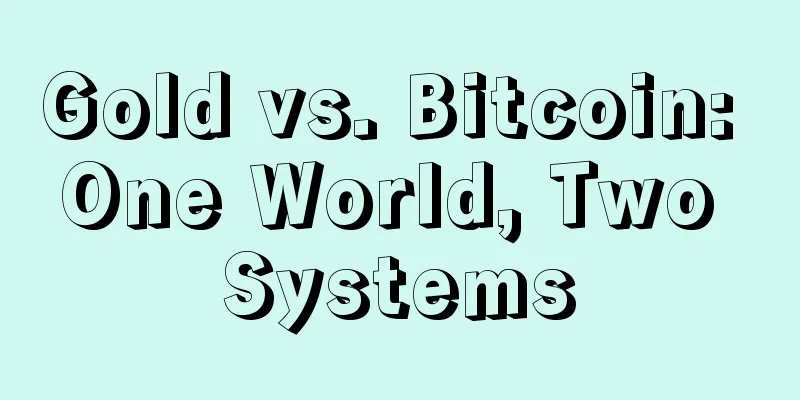Gold vs. Bitcoin: One World, Two Systems

|
In 2024, the prices of two assets in the global investment market hit new highs, which was ridiculed as "the speed of updating research report titles cannot keep up with the speed of setting new highs in prices." What are these two assets? That’s right, gold and Bitcoin. Behind the continued surge in the value of these two assets is a change in their long-term narratives. In today’s lecture, we will discuss one by one what changes have occurred in the narratives of gold and Bitcoin, and whether these changes can continue in the future. The logic behind gold price fluctuations: anti-inflation, risk avoidanceLet’s start with gold. Let's think back for a moment, why do we buy gold? Most people will blurt out: Gold preserves value and resists inflation. That’s right, in the past 100 years of gold investment history, the fluctuations in gold prices mainly came from the two factors of “anti-inflation” and “safe haven”. Here we take a brief look back at the history of currency: In human history, gold has served as the world currency for thousands of years, and its function as a "store of value and means of payment" has been deeply rooted in people's minds. After the Bretton Woods system in 1945, the US dollar became the world currency, but at that time the US dollar was still linked to gold. It was not until 1971 that the US dollar and gold were decoupled, and gold withdrew from the world currency stage. However, as the most deeply rooted currency in human history, gold has become a hedge against the US dollar monetary system. Whenever there are inflation expectations or world turmoil, people begin to doubt and waver in the current monetary system, and often rush to the "white moonlight" of the past world, gold. For example, after the Internet bubble in 2000, after the financial crisis in 2008, and after the COVID-19 pandemic in 2020, the Federal Reserve has vigorously cut interest rates and implemented quantitative easing policies, and the price of gold will rise at this time. In late October 2024, the price of gold exceeded $2,800 per ounce, which is also related to inflation expectations. At that time, Trump's chances of winning the election increased, and his policy proposals, including tariffs, fiscal expansion, and tightening immigration, would increase inflation, so the market responded to this expectation in advance. Similarly, Brexit, Sino-US trade frictions, Russia-Ukraine conflicts, Middle East disputes... As long as there are signs of unrest, the price of gold will also rise, which is the same as the old Chinese saying "antiques in prosperous times, gold in troubled times". Figure Gold price trend over the past 20 years The new narrative of gold after 2022: island chainIt seems that the rise in gold prices in the past two years is related to the world turmoil caused by the conflict between Russia and Ukraine and Trump's victory, which is still a risk-averse logic. But in fact, under the similar surface phenomena, the underlying logic has already been subtly different. In the 4th lecture of "Xiang Shuai China Wealth Report (2020-2021)" in 2021, I predicted that gold will have a large return (eg not less than 20%) in the next two years. At that time, my logic was that the monetary policy easing after the epidemic would bring inflation expectations. To date, the increase in gold has far exceeded my expectations, but frankly speaking, the anti-inflation factor in such a huge increase in gold may be weaker than I expected at the time (because Bitcoin, as digital gold, plays a part in the anti-inflation function), but the island chain factor in the world political structure is much stronger . "Island chainization" is a term I proposed in 2022. It describes the situation after the Russia-Ukraine conflict, in which the globally integrated flat market has become a large island that is independent of each other, but there are still intricate chain connections of capital/trade/manpower between them, just as former French Prime Minister Dominique de Villepin described it as "one world, two systems" - from a monetary perspective, this means that the original status of the US dollar as the single world currency has undergone subtle changes . During the Russia-Ukraine conflict, the United States froze Russia's foreign exchange reserves of 300 billion US dollars. Because the foreign exchange reserves of various countries are mainly US dollar assets, the central banks of many countries naturally have the need to "diversify and diversify risks". There are not many major assets independent of the US dollar system, and gold is an important one. Since 2022, the super buyers in the global gold market have become governments. The demand for gold purchases by central banks of various countries, including China, India, Turkey, and Russia, has increased fivefold. Table 2. Changes in gold reserves of various countries In short, the world is moving from "globalization" to "island chain", and asset allocation has also begun to evolve under the logic of "one world, two systems". The rise in gold prices is the embodiment of the new narrative under the island chain political ecology. A 2024 World Gold Council survey showed that 29% of central banks intend to increase their gold reserves in the next 12 months, the highest level since the survey was launched in 2018; 81% of central banks expect global gold reserves to increase in the next 12 months. These data and surveys show that the "island chain narrative" has become a basic support for the medium- and long-term gold price. In addition to anti-inflation and risk aversion, the rise and fall of gold prices may be closely related to the global "island chain" trend. If this trend continues, then the gold price will have a certain support. Of course, inflation and risk aversion still have an important impact on the gold price: for example, after Trump takes office, if the Palestinian-Israeli issue and the Russian-Ukrainian conflict can be resolved, then it may be a negative impact on gold. Bitcoin: From resistance narrative to transaction narrativeAfter talking about gold, let’s take a look at Bitcoin. I need to remind you that Bitcoin trading is illegal in China. But you may need to understand that in the global investment market, in a sense, Bitcoin and gold are assets of the same nature: first, they are both supplements and substitutes for existing sovereign credit currencies; second, they are not supported by cash flow, and their value is mainly based on people’s common beliefs, that is, relying on narratives. As the narrative of gold changes with the "island chain" of the world's political landscape, the underlying logic of Bitcoin has undergone even more significant changes. The US dollar system has shifted from "restriction" to "incorporation" of Bitcoin, and Bitcoin has gone from being a "marginal figure" in the US dollar system to a "mainstream asset" in the digital dollar system. Two years ago, in the 6th lecture of the 2022 "Xiang Shuai China Wealth Report (2022-2023)", I once described in detail that the US government's attitude towards Bitcoin took a 180-degree turn between 2020 and 2022: from "illegal, speculative, and inefficient" to "innovative and important". This shift means that the US dollar system has shifted from "restricting" Bitcoin to "incorporating" it, incorporating the digital encryption ecosystem into the US financial regulatory system. Federal Reserve Chairman Powell said, "Bitcoin is like gold, existing in digital form" - this means that the US government's calculation is that in the digital dollar system, there is no existence as independent of the US dollar system as gold. As digital gold, Bitcoin has gradually become an important part of the "digital dollar" hegemony. From 2022 to 2024, the United States has even pressed the accelerator of "incorporation". The digital encryption ecosystem, which has grown wildly for more than a decade, has gradually been incorporated into the U.S. financial regulatory system, and the credit of the U.S. dollar has also been "extended" in the digital world: in January and July 2024, the U.S. Securities and Exchange Commission (SEC) approved the Bitcoin spot ETF and Ethereum ETF for the first time, paving the way for many U.S. institutional investors to allocate crypto assets. In November 2024, Trump's victory in the election brought this "recruitment" narrative into a carnival. During the campaign, Trump used the title of "cryptocurrency president" to win more support. Many of Trump's team's staunch supporters, including Musk, Peter Thiel and other bigwigs, are supporters of the digital encryption industry. This is also the reason why the price of Bitcoin has directly exceeded $100,000 from less than $70,000 since November. Of course, the price fluctuation of Bitcoin is much greater than that of gold. It is not uncommon for it to double in a few months, and it is not uncommon for it to halve in a few months. Like all financial assets, the price of Bitcoin will overreact and of course over-adjust. But overall, under the narrative of "incorporation", the positioning of crypto assets in the US financial market is no longer "alien", but digital gold in the "digital dollar system". |
Recommend
What does a man with good looks look like? What are the facial features that good men have?
Nowadays, there are many people who like to disgu...
Is it bad appearance for a woman with a prominent nose bridge? What does a woman with a prominent nose bridge mean?
A person's life destiny is divided into two p...
The face of a woman who plays a sister-brother relationship
The face of a woman who plays a sister-brother re...
The biggest advantage of Bitcoin
There is no doubt that Bitcoin has created countl...
What does a mole at the corner of the eye mean? Is the mole at the corner of the eye a teardrop mole?
The traces left by moles in different positions a...
How to tell if a man is a playboy by looking at his nose
For a woman, the most frightening thing is that t...
How to judge a woman's fortune from her figure
In physiognomy, if a woman is small in stature, i...
What does a mole on the ring finger mean? What does a mole on this part mean?
What does a mole on the ring finger mean? The rin...
Analysis of the face of a woman who likes to be self-centered and has a lion nose
Do women with lion noses have good luck? “If you ...
Dead fish eyes fortune telling
Dead fish eyes are a type of eyes with too much w...
What does the Seven Killings in the Fude Palace represent?
The Qi Sha star is of the Yin metal type and is t...
What kind of mouth shape has the best fortune?
Click here to enter more fortune calculations Lip...
Why are men with single eyelids popular? Are men with single eyelids easy to get along with?
Single eyelid men have strong working ability If ...
People who will fall into the peach blossom trap
People who will fall into the peach blossom trap ...
What is the secret of women's mouth shape from their face?
The shape of a woman's mouth can generally be...









